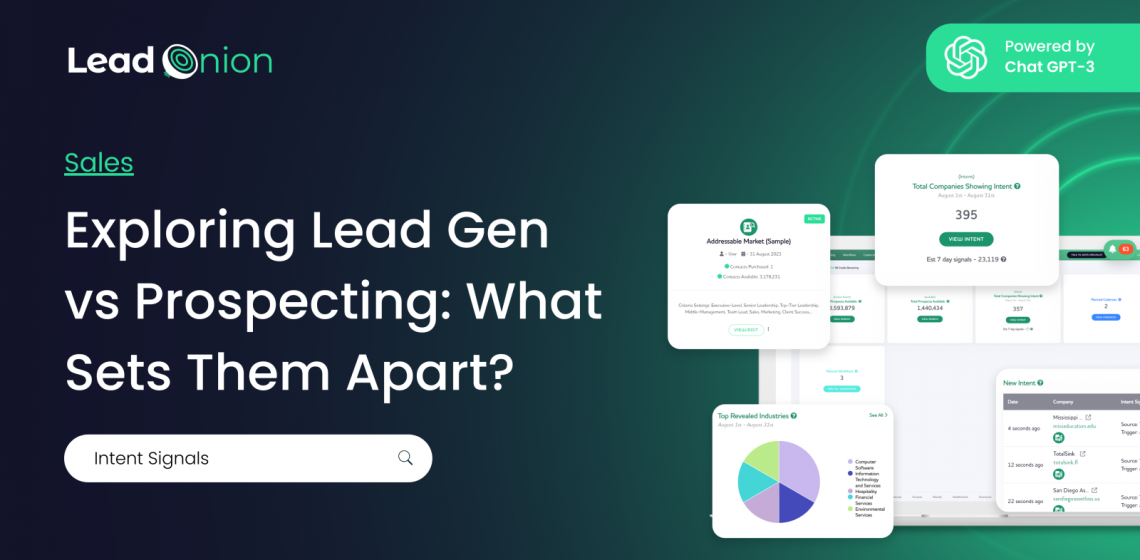Let's clear the air: lead generation and sales prospecting might sound like two peas in a pod, but they're more like apples and oranges when it comes to tactics. These marketing and sales strategies march to different beats, yet both aim for the same prize: sealing the deal. But which one suits your needs better? That's the million-dollar question, and we've got the answers.
So, what sets lead generation apart from prospecting?
Picture this: lead generation kicks off the party by enticing folks who already have a glimmer of interest in your product. It's like laying down a trail of breadcrumbs through your website or social media, leading potential customers right to your doorstep. The endgame? Convincing these leads to cozy up to your brand or welcome a chat with your sales squad.
On the flip side, we've got sales prospecting:
Here, we're talking about cold-calling Sherlock Holmes-style. Prospecting isn't about waiting for someone to knock on your digital door; it's about rolling up your sleeves and digging deep to uncover those hidden gems—the prospects who haven't even heard your brand's name whispered in the wind. With a little detective work and a dash of charm, your sales team swoops in to turn these prospects into loyal customers.
Let's dive deeper into the battlefield of lead generation versus prospecting. There's a multitude of distinctions that surface across various stages. Here's a comprehensive breakdown with real-world examples:
Lead Generation Examples: Techniques
In the realm of lead generation, content reigns supreme. The golden rule? It's all about delivering the right message through the right channels. To master this, start by dissecting how your target audience conducts their product research. Armed with this insight, you can craft a compelling narrative using a variety of mediums such as blogs, whitepapers, webinars, and videos.
Typically, content creation falls under the marketing umbrella in a lead generation model. The aim? Building a roster of marketing qualified leads (MQLs). Once this treasure trove of potential customers is amassed, it's handed over to the sales team. Here, they deploy their arsenal of lead generation strategies to transform lukewarm leads into piping hot prospects ripe for conversion.
Sales Prospecting Examples: Techniques
In the realm of sales prospecting, it's the sales team that shoulders the bulk of the responsibility. Here's a peek into their toolkit:
1. Harnessing Sales Intelligence Platforms: Armed with sales intelligence tools like Lead Onion, sales reps unearth personalized contact information, laying the groundwork for meaningful interactions.
2. Refining Lead Qualification Systems: Implementing an effective lead qualification system ensures that only the most promising prospects make it through the pipeline, saving time and resources.
3. Crafting Killer Cold-Calling Scripts: A well-crafted cold-calling script is akin to a silver bullet in the world of sales prospecting. It's the key to sparking interest and initiating meaningful conversations.
4. Adhering to Best Practices: From setting daily call quotas to pinpointing the optimal time for outreach, sales professionals adhere to a set of best practices honed through trial and error.
While sales reps often take the lead in prospecting endeavors, they're not left to fend for themselves. Collaboration with the marketing team, particularly in leveraging platforms like Lead Onion, is crucial for success. Furthermore, alignment between sales and marketing is imperative for prospect qualification, ensuring that sales reps are equipped with the necessary collateral and delivering a cohesive message regarding product offerings.
Lead Generation Examples: Tools
When it comes to tools, lead generation is all about optimizing every touchpoint between your brand and a potential lead. Here's a glimpse of the tech stack:
1. Lead Enrichment Platforms: These platforms provide invaluable insights to qualify and segment leads, enhancing targeting precision.
2. Email Marketing and Automation Systems: These tools facilitate seamless communication with leads, nurturing relationships and keeping your brand top-of-mind.
3. Live Chat and Messaging Systems: Instantaneous communication channels like live chat enable real-time engagement with website visitors, fostering meaningful interactions.
The overarching goal of these lead-generation tools? Elevating awareness of your product in a manner that piques curiosity and prompts further exploration.
Sales Prospecting Examples: Tools
In the realm of B2B prospecting, it's all about arming yourself with the information necessary to connect with the most relevant prospects. Here's where the tools come into play:
- Buyer Intent Data:
This treasure trove of insights unveils the digital footprints left behind by potential buyers as they navigate the vast landscape of the internet. By harnessing advanced algorithms and machine learning, Buyer Intent Data sifts through online behaviors, revealing subtle cues and indicators of purchase intent.
.png)
Armed with this intelligence, sales professionals gain unparalleled visibility into the minds of their prospects, enabling hyper-targeted outreach and personalized engagement. Whether it's monitoring keyword searches, tracking website visits, or analyzing content consumption patterns, Buyer Intent Data empowers sales teams to strike while the iron is hot, reaching out to prospects at the precise moment when they're most receptive to your message.
- Contact Search:
Lead Onion's Contact Search stands out as a beacon of efficiency and precision. With an extensive repository of verified contact information, this database serves as the compass guiding sales professionals to their ideal prospects with the ability to filter results based on contact and company properties e.g Job Title or Employee Size.

Harnessing the power of Lead Onion's Contact Search, sales reps gain access to a wealth of invaluable data, from email addresses to phone numbers, LinkedIn profiles to company affiliations. This comprehensive resource empowers sales teams to streamline their prospecting efforts, eliminating the guesswork and enabling targeted outreach with surgical precision.
Finding Your Sweet Spot: Balancing Quality and Quantity
Navigating the labyrinth of sales and marketing strategies can be daunting, but fear not—we're here to shed light on finding the perfect fit for your company's needs.
Many savvy companies opt for a hybrid approach, blending the best of both worlds: lead generation and sales prospecting. Why? Because they understand the importance of striking the right balance between quality and quantity.
Sure, lead generation gets your foot in the door—after all, you've already cleared the hurdle of getting your name out there. But unless your brand boasts the clout of a household name, relying solely on organic traffic from website visits and social media engagements may not suffice to meet your lofty sales goals.
Enter sales prospecting, the ace up your sleeve for ramping up volume. While the conversion rate for each prospect might be lower compared to leads, the sheer abundance of contacts derived from a robust lead generation process offers ample opportunities to tip the scales in your favor.
The Power of Continuous Improvement
The secret sauce? Continuous refinement across the board. Take content analysis, for instance. By dissecting conversion rates tied to various content types, you'll unearth invaluable insights into which messaging strikes a chord with your leads most effectively.
Likewise, while the prospect of making endless calls may seem daunting, sales prospecting techniques wield immense power when paired with the right methods. These techniques aren't just about filling your pipeline; they're about qualifying prospects meticulously, ensuring your team's precious time is invested in nurturing those that align closely with your ideal customer profile.
Here are some key advantages of prospecting via Buyer Intent Data:
- Hyper-Targeted Outreach: Buyer Intent Data enables sales teams to pinpoint prospects who are actively researching products or services similar to theirs. This hyper-targeted approach ensures that outreach efforts are focused on prospects with a genuine interest in what your company offers.
- Timely Engagement: By leveraging Buyer Intent Data, sales reps can reach out to prospects at the precise moment when they are most receptive to your message. This timely engagement increases the likelihood of sparking meaningful conversations and driving conversions.
- Enhanced Personalization: Armed with insights from Buyer Intent Data, sales professionals can tailor their outreach efforts to align with the specific needs and preferences of each prospect. This enhanced level of personalization fosters stronger connections and builds trust with potential customers.
- Improved Conversion Rates: Prospecting with Buyer Intent Data leads to higher conversion rates, as sales reps are targeting prospects who are actively in the market for your products or services. This increased relevance translates into more meaningful interactions and a greater likelihood of closing deals.
- Streamlined Sales Process: By focusing efforts on prospects exhibiting genuine interest, sales teams can streamline their sales process and allocate resources more efficiently. This targeted approach maximizes productivity and minimizes wasted effort on unqualified leads.
- Competitive Advantage: Leveraging Buyer Intent Data gives companies a competitive edge by enabling them to identify and engage with prospects ahead of the competition. By staying ahead of the curve, businesses can capture market share and drive revenue growth.
In essence, success lies in the art of adaptation—constantly fine-tuning your strategies based on real-world feedback and data-driven insights. By embracing a dynamic approach that seamlessly integrates lead generation and sales prospecting, you'll unlock the door to sustained growth and unparalleled success in the ever-evolving landscape of sales and marketing.
Why Lead Onion?
Lead Onion isn't just another tool—it's a sophisticated powerhouse designed for sales and marketers alike. With the ability to source and decode 18 diverse sources of intent signals all in one place, Lead Onion revolutionizes the way we approach customer acquisition. Like peeling back layers, Lead Onion guides us through the intricate nuances of the buyer's journey, ensuring precision and refinement in every step.
.png)
By adopting Lead Onion, the path to unparalleled success in B2B demand generation becomes crystal clear. Let's peel back the layers together and embark on a journey towards refined, customer-centric success with Lead Onion by our side.
Conclusion
In the realm of customer acquisition, lead generation and sales prospecting stand as two distinct yet complementary strategies. Lead generation casts its net wide, leveraging captivating marketing assets to entice potential buyers into the fold.
Meanwhile, sales prospecting takes a more proactive approach, delving into the trenches to unearth promising leads ripe for conversion. These strategies diverge not only in their techniques but also in the tools that support their endeavors.
However, the real magic happens when companies embrace both approaches, seamlessly integrating lead generation and sales prospecting into a cohesive strategy.
Through continuous refinement and optimization, businesses can strike the perfect balance, maximizing their conversion potential while ensuring that no opportunity slips through the cracks.
It's the synergy between these two methods that unlocks the door to sustained growth and success in the competitive landscape of sales and marketing.
Try Lead Onion for FREE for 7 days today. Sign up below.



